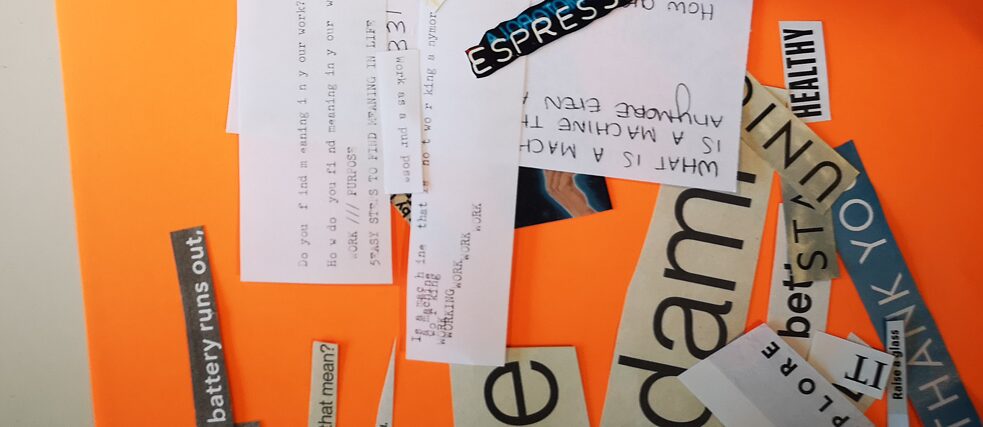Zines
Analog reflections on tech

© Tatiana Braun
As part of the NAO residency, the team of researchers organized a workshop for making a zine that deals with the intricacies of a life dominated by technology.
By Priscilla Jolly
The ‘Robots in Residence’ program at the Goethe-Institut Montreal aimed to foster new reflections about human-machine relations. The residency leaders Ceyda Yolgormez, Patil Tchilinguirian and Zeph Thibodeau concluded NAO’s journey with a zine making workshop with NAO. This making workshop was an opportunity to further deepen conversations that had emerged about human-machine relationships.
Slowing Down
There is no getting around it: machines make human life easier. Take for instance, the daily of a morning coffee or buying a coffee from a café. To enjoy coffee as a beverage, the beans and processed, ground into powder and then, the powder is processed in a machine to make the brew. The machines make the process faster and more efficient, saving time. They make work easier. Thus, in popular imagination and techno fantasies, machines are key to imagining a world where everything is faster and more efficient.In contrast to this quest for speed, the zine making workshop invited participants to slow down. The workshop began with a series of prompts on human relationships to machines. Is there a machine in your life that inspires strong feelings in you? If so, how did the two of you get to this point? Then, participants were invited to design a collage based on their reflections. The residency leaders provided materials required for this exercise. Two tables in the workshop space, located at the Milieux Institute at Concordia University, were filled with old magazines, cut outs of photographs, zines from different parts of the world for inspiration, and old machines.
Participants chose different colored papers, cut images out from magazines and browsed numerous cut photographs in order to find material for their collages. Unlike this article, which was written on a word processing software on a machine, which allows the writer to see text materialize on the screen instantly, making a collage for a zine was a slow process. Participants carefully chose their individual elements and then spent time in thinking about how best to arrange these elements on their chosen media. The room was filled with sounds of scissors running through paper. This exercise was not a quest for speed; on the contrary, it asked participants to take a moment and reflect about the machines in their life.
Making the Zine
Thinking about machines in our lives inevitably leads us to see how enmeshed machines are in daily lives. From coffeemakers, teakettles, microwaves and laptops, everyone interacts with machines in some form or the other. The workshop participants were invited to think about machines that they had emotional connections with. This led to the creation of different narrative arcs.For instance, one participant created a small booklet about a moving story about losing an iPod and how a stranger gave them another one. Someone else decided to go the route of superhero films, featuring a vacuum cleaner as the central character. There were collages inspired by critical theory and user interfaces, as well as personal reflections about machines. One participant created pop-up art involving robots and balloons. And of course, there were collages on NAO, the center piece of the residency.
Collages provided insight into human-machine relationships. In daily lives, machines are often relegated to the background. They come to the forefront only when they stop working or when deviate from what is expected of them. A refrigerator that does not chill food is no longer a ‘working’ refrigerator. Working on collages inspired by machines gave the participants a chance to go beyond the trope of machine-as-utility. Instead, these collages became ways to reflect on affective bonds between humans and machines and how everyday lives are structured by these bonds.
Human-Machine Relationships
The zine making process was also a chance for everyone involved in the workshops to contemplate the different facets of work. Machines are often used to reduce work and to work faster. It is certainly possible to design a zine on a computer and then to have it printed. Contrast the process of designing something on a machine as opposed to doing something by hand. Doing something by hand makes it possible to feel the materiality of things. This connects to the larger theme of the residency, considering NAO’s ill health.NAO’s ill health forced everyone to pay attention to NAO’s materiality, what NAO was made of, and what wear and tear their body was subject to. This materiality and the understanding that bodies are indeed fragile became even more important during the residency as NAO had trouble booting up. Through the process of zine-making, some participants chose to engage with the same question: mortality of machines. If it is a small machine, such as an iPod, it is possible to keep the machine even when it is not useful or when it has outlived its purpose. However, what happens when large machines outlive their utility? For instance, the city of Montreal requires larger electronics be dropped off at eco-centers where old machines and electronics can be disposed of in safe way.
What will happen to NAO at the end of their life? This question led to the uncomfortable answer that sometimes it is cheaper for companies to replace a product rather than repair it. The workshops closed on this uncertain, slightly anxious note regarding NAO’s fate. However, these concerns and other affective engagements with the machines found creative expression through zine making, an expression of community building, driven by reflections on how machines inhabit our lives. The zine is a testament to ‘matters of care,’ with respect to our non-human, machine friends who play a vital part in making our worlds livable.
Comments
Comment